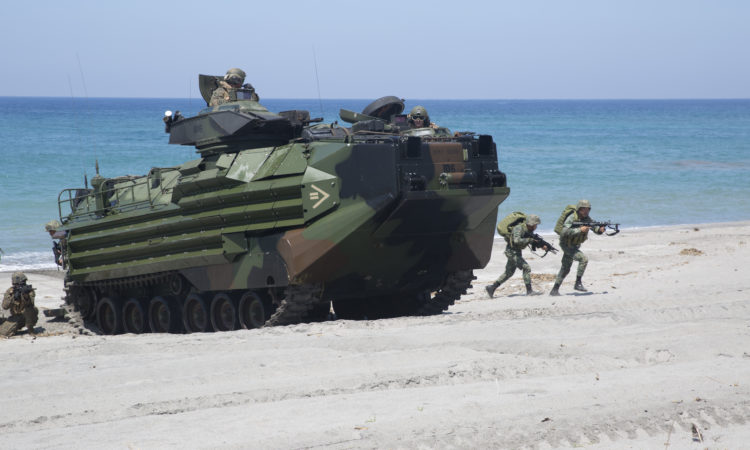

In the months ahead, expect the United States military to be very visible in the Philippines as Washington steps up training and exercises in the region, reassuring allies and partners of its commitment to remain in the Indo-Pacific area to stymie China’s creeping influence.
This year alone, two top US foreign policy and security officials visited Manila to secure a commitment from Filipino officials that the Philippines will remain a reliable ally and partner to counter Beijing’s assertive behavior in the region.
In March, US State Department Mike Pompeo reaffirmed US commitment to the 70-year-old Mutual Defense Treaty with its oldest ally and former colony, and help repel any attack on any soldier, ship and aircraft not only within its borders but also in the disputed South China Sea.
The Philippines has long been seeking this assurance as past US administrations were ambiguous in their positions, unlike in Japan when the US was ready to assist a former foe against foreign aggression. The US keeps several bases in Japan after withdrawing from the Philippines in the early 1990s. It gained wider access to local bases in the previous administration when the Enhanced Defense Cooperation Agreement was signed in 2014.
The latest visitor was Pentagon chief Mark Esper, who has marked China as a priority threat in the increasingly big power competition that has eclipsed terrorism and extremism as the United States’ most urgent and long-term security concern.
Since August this year, Esper has been calling for expanded base locations in the Pacific while ordering the US Navy and Air Force to increase the tempo of freedom of navigation and overflights in disputed areas in the South China Sea to challenge China’s island-building activities.
Based on the US’ free and open Indo-Pacific Strategy, Washington has been looking for access points throughout the region where it can sustain engagement to build capable partners and strengthen deterrence. The Philippines and Singapore are among possible allies and partners that can withstand a buildup in US presence.
However, some in Washington doubted if Manila, under President Rodrigo Duterte, could still be a reliable ally and partner.
In a telephone press event with journalists on Friday, Gen. Charles Brown, commander of US Pacific Air Force, was careful with his words as regards basing agreements with the Philippines, although he did mention plans to help “equip these airfields to be able to support the Philippines” during humanitarian assistance and disaster response operations.
“So, really, it’s not about basing,” Brown said. “There’s really no military presence or expanding presence. I would say it’s just the increased level of interoperability.”
Brown said his goal was to improve the quality of training the US air force units have with allies and partners in the region, like the Philippines, and help provide capacity and capability in domain awareness.
In a joint statement after holding talks last month with his Filipino counterpart, Delfin Lorenzana, Esper also pledged to increase basing investments in when he talked about “improving defense infrastructure through the Enhanced Defense Cooperation Agreement (EDCA).”
Sources at the local defense and military estabishments said the US had lined up several projects at the Benito Ebuen Air Base in Mactan, Cebu and at the Antonio Bautista Air Base in Palawan for 2020, possibly involving the improvement of runways and building structures to support humanitarian assistance and disaster response (HADR) operations there.
Esper and Lorenzana had also discussed US proposals to help modernize the Armed Forces of the Philippines, improve maritime security capabilities and domain awareness. They also discussed ways to deepen and expand cooperation through training and exercises, including cybersecurity capability.
What is becoming clear after Pompeo and Esper’s visits to Manila were US efforts to secure commitments from allies and partners in the region to support the new Indo-Pacific strategy and a reassurance of its continuing presence in the region.
Since the 1990s, the US Air Force has reduced the number of its tactical aircraft by 3,000 and personnel by about 300,000. Cuts were made in Europe and in the continental US but Washington pledged to maintain its footprints in the Indo-Pacific region due to the rise of China.
Thus, expect US bombers, fighters, surveillance and other type of planes to continue overflights in the East and South China Sea. With more assets rotating from US bases in South Korea and Japan to co-located airfields where they have access in Southeast Asia, northern Australia and to bases shared with the United Kingdom in Diego Garcia, the coming months will be extremely busy for the US Air Force.
The US Navy, joined by the US Coast Guard, will also be very busy steaming on disputed waters doing freedom of navigation operations (Fonops) patrols or exercising with navies from allied countries, including former enemy Vietnam.
2020 will indeed be a very busy year for the US and its allies and partners.
